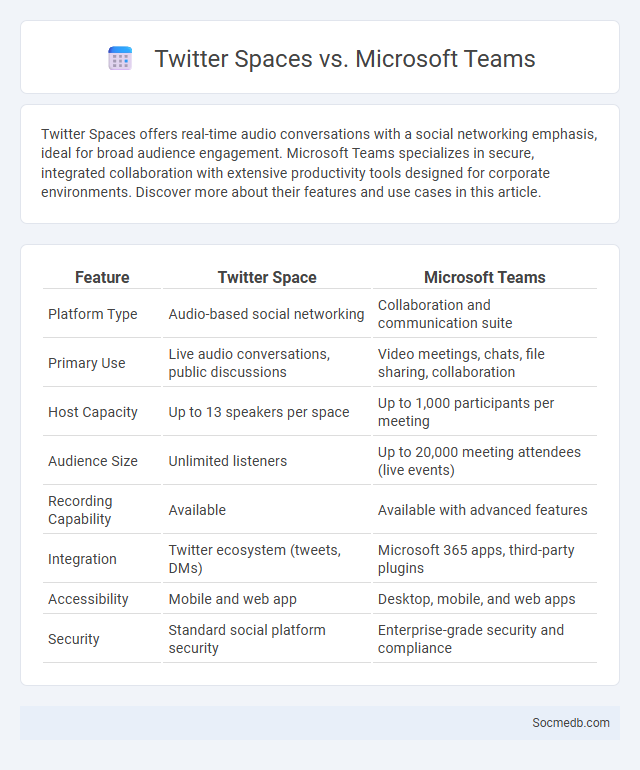
Photo illustration: Twitter Space vs Microsoft Teams
Twitter Spaces offers real-time audio conversations with a social networking emphasis, ideal for broad audience engagement. Microsoft Teams specializes in secure, integrated collaboration with extensive productivity tools designed for corporate environments. Discover more about their features and use cases in this article.
Table of Comparison
| Feature | Twitter Space | Microsoft Teams |
|---|---|---|
| Platform Type | Audio-based social networking | Collaboration and communication suite |
| Primary Use | Live audio conversations, public discussions | Video meetings, chats, file sharing, collaboration |
| Host Capacity | Up to 13 speakers per space | Up to 1,000 participants per meeting |
| Audience Size | Unlimited listeners | Up to 20,000 meeting attendees (live events) |
| Recording Capability | Available | Available with advanced features |
| Integration | Twitter ecosystem (tweets, DMs) | Microsoft 365 apps, third-party plugins |
| Accessibility | Mobile and web app | Desktop, mobile, and web apps |
| Security | Standard social platform security | Enterprise-grade security and compliance |
Overview: Twitter Space, Microsoft Teams, and Space Defined
Twitter Spaces allows users to host live audio conversations, fostering real-time engagement among followers and communities. Microsoft Teams integrates robust collaboration tools with audio and video conferencing, making it ideal for professional communication and teamwork. Understanding the distinct features of Spaces in these platforms helps you leverage social media for both casual interaction and structured collaboration effectively.
Features Comparison: Audio, Video, and Collaboration Tools
Social media platforms offer diverse features for audio, video, and collaboration tools to enhance user interaction and content sharing. Your choice should consider audio capabilities like live streaming and voice messaging, video functionalities such as high-resolution uploads and live video rooms, and collaboration tools including shared documents and group chats. Evaluating these features helps optimize engagement and communication efficiency on your preferred social media network.
User Experience: Interface and Accessibility
Intuitive social media interfaces enhance user experience by simplifying navigation and ensuring content is easily accessible to diverse audiences, including those with disabilities. Features like customizable privacy settings, clear visual hierarchy, and adaptive design improve engagement and make Your interactions seamless across devices. Optimizing accessibility through screen reader compatibility and keyboard-friendly controls ensures inclusive access for all users.
Integration Capabilities: Third-Party App Support
Social media platforms with robust integration capabilities enable seamless third-party app support, enhancing user experience through diversified functionalities. These integrations facilitate real-time data sharing, streamlined workflows, and expanded content creation tools, driving higher engagement rates. Leading platforms like Facebook, Instagram, and Twitter leverage APIs to connect with marketing automation, analytics, and customer relationship management (CRM) applications.
Audience Engagement: Polls, Q&A, and Moderation
Maximizing audience engagement on social media involves incorporating interactive elements such as polls and Q&A sessions to stimulate participation and gather valuable insights. Implementing effective moderation ensures a positive and respectful environment, fostering meaningful conversations and enhancing the overall user experience. These strategies boost user interaction metrics, increase content visibility, and strengthen community loyalty.
Platform Security and Privacy Measures
Social media platforms implement robust security protocols such as end-to-end encryption, multi-factor authentication, and regular security audits to protect user data from breaches and unauthorized access. Privacy features include customizable settings for content visibility, strict data-sharing policies, and compliance with regulations like GDPR and CCPA to ensure user control over personal information. Continuous updates in platform algorithms and vigilant monitoring help detect and prevent cyber threats, enhancing overall digital safety.
Scalability: Limits on Participants and Usage
Social media scalability faces constraints due to platform architecture and server capacity, which limit the number of active participants and content interactions simultaneously. User growth can lead to latency issues and degraded performance unless infrastructure upgrades like distributed computing and cloud services are implemented. Efficient data management and algorithm optimization are critical to maintaining seamless user experiences as social networks expand globally.
Pricing Structures and Subscription Models
Social media platforms utilize diverse pricing structures, including freemium models that offer basic features for free while charging for premium access or exclusive content. Subscription models vary from monthly or annual fees to tiered plans that unlock advanced analytics, ad-free experiences, or enhanced engagement tools. This approach enables platforms like LinkedIn Premium, YouTube Memberships, and Twitter Blue to monetize user engagement effectively.
Use Cases: Business, Education, and Community
Social media platforms empower businesses to enhance brand visibility, engage directly with customers, and drive e-commerce sales through targeted advertising and influencer partnerships. In education, social media facilitates collaborative learning, resource sharing, and virtual classrooms that connect students and educators across the globe. Communities utilize social media to organize events, foster support networks, and amplify collective voices, making it a vital tool for social interaction and mobilization.
Final Verdict: Choosing the Right Platform for Your Needs
Selecting the right social media platform depends on your target audience, content type, and business goals. Platforms like Instagram excel for visual storytelling, while LinkedIn is ideal for professional networking and B2B marketing. Matching your objectives with the platform's strengths ensures maximum engagement and ROI for your social media strategy.
 socmedb.com
socmedb.com